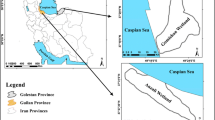Abstract
Crab samples, both male and female specie, were purchased from fishermen at the Ojo Rivers, Lagos, Nigeria. The samples separated into abdomen, muscle tissue, and thorax were oven dried at 80°C for 3 days. The dried samples were then pulverized in a clean acid-washed mortar and pestle. Approximately 1.00 g each of the pulverized samples was weighed and Zn, Cr, Pb, and Cd were determined in the solution of the aqua regia digested samples by means of AAS (Buck Scientific 210 GVP model). The results obtained showed Zn metal to be consistently higher in all the female parts compared to the male with values of 12.92 ± 3.65 μg/g to 16.03 ± 1.08 μg/g and 9.33 ± 1.77 μg/g to 15.75 ± 1.02 μg/g, respectively. Mean values of 0.39 ± 0.09 μg/g and 0.22 ± 0.02 μg/g cadmium were found in the abdomen and tissue of the male crab as against 0.35 ± 0.07 μg/g and 0.17 ± 0.07 μg/g in the female crab. The tissues of both species have comparable value of chromium. Lead was below the detection limit of 0.05 μg/g in the tissues of male crab but the female tissue contained 0.83 ± 0.13 μg/g and in other parts identified, lead was consistently higher than the 2.00 μg/g permissible level of WHO in foods. A simple pair t-test did not demonstrate any significant difference in the distribution of metals between the male and female crabs. The coefficient of variation (CV) calculated for each metal with respect to the studied parts showed Pb to be widely distributed (56.23–89.54%) while Cr did not vary widely (4.17–8.20%).
Similar content being viewed by others
References
Adekoya JA, Williams AB, Ayejuyo OO (2006) Distribution of heavy metals in sediments of Igbede, Ojo and Ojora Rivers of Lagos, Nigeria. Environmentalist 26:277–280. doi:10.1007/s10669-006-9077-1
Adeyeye EI (1994) Determination of trace heavy metals in Illisha Africana Fish and in associated water and soil sediments from some fish ponds. Environ Stud 45:231–238. doi:10.1080/00207239408710898
Adeyeye EI, Ayejuyo OO (2002) Assessment of the physicochemical status of a textile industry’s effluent and its environment. Pak J Sci Ind Res 45(1):10–16
As Mohana MV, Subromanyam SY (2001) Flux of heavy metal accumulation in various organs of crab. Environ Int 27:321–326. doi:10.1016/S0160-4120(01)00063-0
Ayejuyo OO, Olowu RA, Megwa KC, Denloye AAB, Owodeinde FG (2003) Trace metal in Clarias lazera, water and sediment from Majidun River, Ikorodu Nigeria Res Commun Fish 1(1):27–31
Ayejuyo OO, Raimi OG, Moisili OR (2005) Determination of trace metals in Silver Cat Fish (Chryssichthys nigrodigitatus), associated water and soil sediment from Beach line Fish Ponds. Pak J Sci Ind Res 48(1):39–41
Calmano W, Ahif W, Forstner U (1996) Sediment quality assessment. Chemical and biological approaches. Sediment and toxic substances. Springer, pp 1–34
Chou CL, Paon LA, Moftatt JD, Zwicker B (2002) Copper contamination and chromium, silver and zinc concentrations in the digestive glands of American lobster (Homarus americanus) from the Inner Bay of Fundy Atlantic Canada. Bull Environ Contam Toxicol 65:470–477. doi:10.1007/s001280000148
Forstner UA, Wittman AW (1993) Metal pollution in aquatic environment. Springer Verlag, Berlin, p 48
Fullick A (1994) Advanced Science Biology. Heinemann Educational, London, p 485
Furk and Wasgnalls Corporation (1995) ‘‘Crab’’, Microbiology Encarta Encyclopedia, p 96
Miller JC, Miller JN (1988) Basic statistical methods for analytical chemistry part 1 statistics of repeated measurements. A review. Analyst (Lond) 113:1351–1356. doi:10.1039/an9881301351
Nnagu JO (1988) An epidemic of environment metal poisoning. Environ Pollut 50:139–161. doi:10.1016/0269-7491(88)90189-3
Sager M, Pusco R (1991) Trace element concentration of Oligochaetes and relations in sediment characteristics in the reservoir at Artenworth Austria. Hydrobiologia 226:39–50. doi:10.1007/BF00007778
Seddek ALS, Salem DA, Nagwa ME, Zaky ZM (1996) Cadmium, lead, nickel, copper, manganese and fluorine levels in River Nile fish, Assiut Governorate Egypt. Wien Tierarztl Monatsschr 83(12):374–377
Udoh AP, Udosen ED, Antia BS (1999) Heavy metal contents of Periwinkle (Tympanotonus fuscatus) from different aquatic environments in Akwa-Ibom State of Nigeria in relation with water and sediment. Glob J. Pure Appl Sci 2:189–193
Williams AB, Ayejuyo OO, Adekoya JA (2007) Trends in trace metal burdens in sediment. Fish species filtered water Igbede River Lagos Nigeria. J Appl Sci 7(13):1821–1823
Author information
Authors and Affiliations
Corresponding author
Rights and permissions
About this article
Cite this article
Olusegun, A.O., Olukemi, T.O. & Olukemi, M.B. Heavy metal distribution in crab (Callinectes amnicola) living on the shores of Ojo Rivers, Lagos, Nigeria. Environmentalist 29, 33–36 (2009). https://doi.org/10.1007/s10669-008-9177-1
Received:
Accepted:
Published:
Issue Date:
DOI: https://doi.org/10.1007/s10669-008-9177-1




